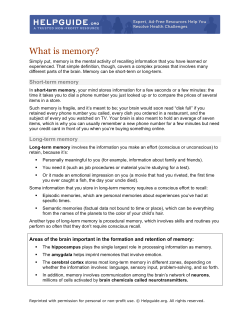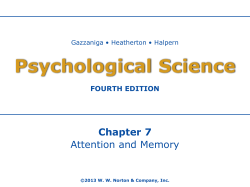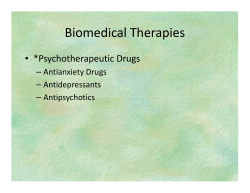
{ How Neurosciences help us to understand some (psycho)therapeutic processes
How Neurosciences help us to understand
some (psycho)therapeutic processes
{
Bernadette Grosjean. MD.
Psychotherapy Seminar Harbor UCLA 2013-2014
“We must recollect that
all our provisional ideas
in psychology will
presumably one day be
based on an organic
substructure”
Sigmund Freud “On Narcissism” 1914.
In 1936 Rosenzweig wondered:
Whether the factors alleged to be operating in
a given therapy are identical with the factors
that actually are operating
Whether the factors that actually are
operating in several different therapies may
not have much more in common than have
the factors alleged to be operating
Several Meta-analyses report no differences among different types
of therapies, although all are superior to no treatment.
Luborsky,L. 1975,1993,1999,2002; Smith & Glass 1977;Grissom 1996; Wampold et al
1997; Ahn and Wampold 2001; Prochaska and Norcross 2003.
Common factors
Operation of implicit, non verbal factors
Formal consistency of the therapeutic ideology as a
basis for reintegration.
Alternative formulation of psychological events
Rosenzweig 1936.
Time travel
{
From neuron to mirror neuron
“SOUL IS DISTINCT FROM THE BODY”
Hippocrates
(460-377
B.C.)
Plato
Athenes
(427-347 B.C.)
René Descartes
Saint Augustin
( 354 -430)
St Thomas
Aquinas
(1225-1274)
(1596-1650)
Santiago Ramon Y Cajal
1852-1934
“The nervous system is made up of billions of
separate nerve cells”.
Nerve cells are polarized, receiving
information on their cell bodies and
dendrites, and conducting information to
distant locations through axons.
"... mental exercise facilitates a greater development of the
protoplasmic apparatus and of the nervous collaterals in the
part of the brain in use. In this way, pre-existing connections
between groups of cells could be reinforced by multiplication
of the terminal branches of protoplasmic appendices and
nervous collaterals".
CAJAL. Royal Society. London 1894
Donald Hebb (1904-1985)
The Organization of Behavior
“ Cells that fire together wire together”
Hebb was fascinated by the way people learned
and the way they retained information.
In 1949, he suggested that the nervous system
was encoding information by strengthening
activated neuronal connections.
Terje Lomo- Timothy Bliss
Long Term Potentiation
“The stimulation of certain neuronal fibers by
high frequency waves creates a significant and
measurable increase in the inter-synaptic
strength, insofar as it increases the ability to
initiate post-synaptic potentials.
Terje Lomo Norway 1966. Timothy Bliss.London, 1973.
LTP
Long-Term
Potentiation
This phenomenon, which
may persist for weeks, is
labeled
long term potentiation
(LTP).”
Eric Kandel
Nobel Prize in
2000.
In 1965 proposed that a form of post-
synaptic potentiation may correspond to a simple
form of learning.
Psychotherapy, like medication, is ultimately
mediated by neuro-anatomical structures
“Successful psychotherapy is
correlated with discrete brain
changes” Etkin, Kandel et al. 2005;
Roffman et al. 2005.
NEUROPLASTICITY
•
•
100 billion neurons
Each develops between 1,000 to 10,000 connections with other neurons
Timeline…
Brain growth spurt in humans between the last 3
months of pregnancy and extends into the first
3 years of life.
Around 18 month dente gyrus (hippocampus)
starts to “create” episodic memory.
Around 4 y/o starts developing autobiographic
memory.
Major Pruning end around the end of puberty.
Adult brain remains plastic during the entire
life.
NEUROPLASTICITY
Development shapes the brain by altering the strength of
synaptic connections within the brain.
New synapses can be formed in response to experience.
Genetic information, toxic substance, and stressful or
absent experience can lead to elimination of synapses.
N-methyl-D-aspartate
subtype glutamate
receptors
{
NMDARs
Glutamate
Glutamate is recognized as a neurotransmitter in 1972
(Watkins).
Primary excitatory neurotransmitter in the mammalian
brain (60%).
Receptors for Glutamate are divided into NMDA and
non NMDAr (AMPA, Kainate).
NMDA-receptor
Hippocampus, forebrain, amygdala, caudate, putamen and thalamus (rodents).
NMDAR, can “detect” the coincidence of 2 events,
so called “associativity”.
LTP is dependent on the presence NMDA receptors
(NMDAR) (Collingridge & al 1983).
Glutamate and NMDAR are involved in many CNS
mechanisms of plasticity including those
contributing to learning and memory.
The period when NMDAR function is critical for
neuronal survival in rats encompasses a period that
in humans extends form the third trimester of
pregnancy to several years after birth. Balâazs et al
2006
Brain
Human: genes around 35,000
We share about 97% of our genes with chimpanzees. Our
closest relative, the bonobo, has about 98.4 % of the same
genes that we do. (just 500 genes #)
Human brains differ from those of other primates in three
main areas- the frontal lobes, the hippocampus, and the
cerebellum.
Those three highly developed brain structures allow
humans to do all sorts of amazing things.
We can manipulate symbols and create realities in our
heads that can stand quite apart from the external reality
that all other animals share.
The advanced processors that allow us to remember,
imagine, plan, and create are still basically wired up to
emotional systems that are not too different from those
of our primate ancestors.
We continue to be driven by the same instincts and emotions. It is as
though we have a super-fast computer hooked up to a chimpanzee
emotional system.
Hippocampus
“Puzzle Assembler”.
Facilitate the storage
of spatial, non verbal
and semantic or
verbal memories that
involve the
encoding of
experience into
powerful symbolic
representation
facilitated by
language
Rich in NMDA receptors
Hippocampus / Dente Gyrus
The dentate gyrus is a site of active
neurogenesis .
I has been hypothesized that it ensure that new
learned patterns do not interfere with the old ones and
remain separable (Viamontes 2008)
Amygdala
“EMOTIONAL BRAIN”
Key role in the emotions (fear, pleasure).
Key role in implicit, emotional memories: interprets the emotional
significance of the experience.
Rich in glucocorticoid and NMDA receptors
Anterior Cingulate Cortex
“Conflict monitoring”
Vital to cognitive functions,
such as reward anticipation,
decision-making, empathy,
and emotion.
ACC is involved in the
processing of the affective
dimension of pain
responsible for rendering new
memories permanent.
NMDA receptor in the prefrontal
cortex are critically involved in
both LTP and contextual
memory (Zhao et al. 2005).
Cerebellum
There is increasing recognition that the cerebellum contributes to
cognitive processing and emotional control in addition to its role
in motor coordination
The cerebellum, along with our frontal lobes and
hippocampus, is much larger in humans than our
physical stature would predict. In fact this
mysterious structure contains over half of the brain's
neurons.
The commonly recognized function of the
cerebellum is the coordination and balance of muscle
movements. Our talents in that area certainly would
not explain the need for such enlarged cerebellums.
Ventral Pre-motor Cortex
...And MIRROR NEURONS
Illustration © Marco Iacoboni
Mirror Neurons
A class of neurons that discharge not only when a monkey
executes goal-related hand action, but also when observing
other individuals executing similar actions.
Gallese, Rizzolatti et al. 1996.
Mirror Neurons
Empathy “Einfühlung”
To empathize, we need to invoke the representation of the actions
associated with the emotions we are witnessing.
In human, fMRI study showed that the same brain region are
activated while observing an emotion or during the imitation of the
emotional face expression
“Neural mechanisms of empathy in human: a relay from neural
systems for imitation in limbic area” Carr, Iacoboni et al 2003.
Environment –
NMDA neurotransmission
{
Stress...
Continuation of, or re-exposure to, stress results in unregulated
excitation of glutamate neurons (Farb et al 1992), and a growing
body of data have implicated glutamatergic neurotransmission
in stress-induced hippocampal atrophy and death (Mc Ewen
1999).
Neglect...
Early maternal separation appeared
to exert a dramatic suppressive effect
on synaptic overproduction in the
early development of hippocampus.
De Bellis et al.2001.
Neonatal isolation impairs
hippocampal-dependent context
conditioned fear in adult rats.
Kosten et al 2007
Fear...
It is impossible to cancel some memories related to fear
once those have been “written” at the amygdala level
(rodents). Ledoux 1996
Neocortex is indispensable for the extinction of the reflex
associated to fear once it has been created through
conditioning.
Animal studies show that important forms of learning
in both the conditioning and extinction of fear are
dependent upon proper function of NMDA
neurotransmission in the amygdala (Miserendino et al. 1990;
Rodriguez et al. 2001; Pietersen et al. 2006).
MAIN POINTS
NMDA neurotransmission:
influences and is influenced by experience.
has a clear impact on cognition (specifically emotion,
affect, motivation, appraisal and evaluation of
environmental stimuli).
Neuronal damage mediated by NMDA
neurotransmission may vary depending on the timing
and the intensity, duration and type of stress.
Appropriate NMDA stimulation may enhance learning
abilities
Changing fear….
http://www.nature.com/nature/videoar
chive/memory/index.html
Recent research on changing fears has examined
targeting reconsolidation. (2010)
During reconsolidation, stored information is
rendered labile after being retrieved. Pharmacological
manipulations at this stage result in an inability to
retrieve the memories at later times, suggesting that
they are erased or persistently inhibited.
Unfortunately, the use of these pharmacological
manipulations in humans can be problematic.
Changing fear….
http://www.nature.com/nature/videoar
chive/memory/index.html
Through a non-invasive technique to target the reconsolidation
of fear memories in humans, Schiller et al provide evidence that
old fear memories can be updated with non-fearful information
provided during the reconsolidation window.
Changing fear….
As a consequence, fear responses are no longer expressed, an
effect that lasted at least a year and was selective only to
reactivated memories without affecting others.
These findings demonstrate the adaptive role of
reconsolidation as a window of opportunity to rewrite
emotional memories, and suggest a non-invasive technique
that can be used safely in humans to prevent the return of fear.
Schiller D, Monfils M, Raio CM, Johnson D, LeDoux JE, Phelps EA (2010) Blocking the
return of fear in humans using reconsolidation update mechanisms. Nature 463:49-53 .
Nature AND
Nurture
In rodents, in comparison with animals reared
by low licking ⁄ grooming mothers, the offspring
of “good” (high licking) mothers showed:
- increased hippocampal NMDA subunit mRNA
expression,
- enhanced synaptogenesis and improved
hippocampal-dependent spatial learning.
Bredy et al 2004
About the good
enough
environment...
Reduced maternal care effect on cognitive
function can be reversed with peripubertal
environmental enrichment. Bredy et al 2003,
2004.
Human Studies
Nurse-visited children born to mothers with low
psychological resources compared with controlgroup counterparts had :
-at 6 months of age were less likely to exhibit
emotional vulnerability in response to fear stimuli
-at 9y/o have better grade-point averages and
achievement test scores in math and reading in
grades 1 through 3
-as a trend, were less likely to die from birth through age
9, an effect accounted for by deaths that were attributable
to potentially preventable causes.
Home Visiting by Paraprofessionals and by Nurses: a Randomized,
controlled Trial. Olds et al; Pediatrics 2002,2004,2007, 2010.
www.nursefamilypartnership.org
Long-term effects of prenatal and infancy nurse home visitation on
the life course of youths: 19-year follow-up of a randomized
trial.Eckenrode J, Campa M et al. Arch Pediatr Adolesc Med. 2010
EPIGENETICS
It is now common knowledge that humans share the
majority (97%)of their genes with monkeys and apes, even
worms and mice
The sequencing of the human genome, completed in 2003.
However, the genome itself turns out to have limited value for
understanding disease and human characteristics.
The real boss?
Scientists are now pinpointing exactly how nurture
affects nature.
Life experiences — from toxin exposure to physical
affection — can alter gene expression in dynamic
and sometimes reversible ways.
http://www.youtube.com/watch?v=ehwFVgQ82ZY
http://kacv.pbslearningmedia.org/resource/biot09.sci
.life.gen.epigenetics/epigenetics/
EPIGENETICS
The real boss
Epigenome literally means "above the genome."
It is a molecular marking system that controls gene
expression without altering the DNA sequence.
In a sense, the epigenome is the genome's boss.
In the initial weeks after an egg is fertilized —
when its cells are rapidly multiplying and
developing into something like a full-fledged
body — the epigenome acts as an overbearing
micro-manager.
Each new cell has identical DNA, but the
epigenome orders some cells to work as, say,
skin cells and others to become neurons.
…so how does neuroscience
apply to psychotherapy work?
( to relationship…to life…)
{
Background…
Brain circuitry (via synapses and eventually
epigenome) is the final (?) common pathway for
the ever-expanding set of methods that can be
used to alleviate psychological distress.
One of them, psychotherapy, can be describe as an
interpersonal process designed to bring about
modifications of feelings, cognitions, attitudes
and behavior which have proved troublesome.”
Strupp 1978.
Background…
Neuronal plasticity is affected by environment not only at
the initial establishment of neuronal circuitries of a
developing brain, but during our entire life through
memory retrieval, (re)- consolidation and rewiring
connections.
Background…
This potential of
neuroplasticity has
considerable implications
when it comes to
rehabilitation processes
such as psychotherapy.
During psychotherapy the
“attachment quality” of the
therapeutic relationship is critical.
Experimental evidence suggests that secure
attachment, is associated with reduction in
amygdala firing (lessening anxiety) and
increases in nucleus accumbens activity
(possibly related to enhanced reward
representations). Bartels and Zeki 2000,2004.
Within the secure attachment achieved
through basic psychotherapeutic
engagement
The new learning is verbal (symbolic) and non
verbal (emotional).
There is activation of circuits involving explicit and implicit
memory & (past) learning (priming, reflex).
Mirror Neurons maybe crucial player in
-our ability for empathy
-our emotional learning and
mentalization processes
In a secure, coherent therapeutic context:
Reactivated schemes are given new implicit (mostly
emotional) and explicit (mostly semantic) valences and a
new recording of new associations (circuits activation)
may take place in a new context.
Experiences turns on the (epi)genetic machinery and
through the synthesis of new proteins, change and create
new brain internal connections.
Common factors ?
Rosenzweig 1936.
Operation of implicit, non verbal factors?
Formal consistency of the therapeutic ideology as a basis for
reintegration?
Alternative formulation of psychological events
Neuroplasticity, quality of attachment, mirror neurons
qualities, ability to “teach” new emotional and cognitive
(symbolic learning)...
“From the perspective of neuroscience, psychotherapy
can be understood as a specific kind of enriched
environment designed to enhance the growth of
neurons and the integration of neural networks”
Cozolino, 2010
1.
2.
3.
4.
5.
Establishment of a safe and trusting relationship
Gaining new information and experiences across
the domains of cognition, emotion, sensation,
behaviour
Simultaneous or alternating activation of neural
networks, that are inadequately integrated
Moderate levels of stress or emotional arousal
alternating with periods of calm and safety.
Integration of conceptual knowledge with
emotional and bodily experience.
“A fragile ego left alone remains fragile.
Medication or superficial support alone is
not a substitute for the feeling that one is
understood by another human being.”
Anonymous
Thank you !
www.bgrosjean.com
"... mental exercise facilitates a greater development
of the protoplasmic apparatus and of the nervous
collaterals in the part of the brain in use. In this way,
pre-existing connections between groups of cells
could be reinforced by multiplication of the terminal
branches of protoplasmic appendices and nervous
collaterals".
CAJAL. Royal Society. London 1894.
© Copyright 2025





















